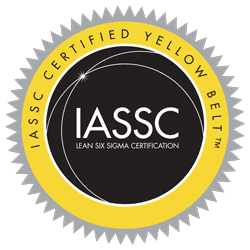The Certified Lean Six Sigma Yellow course is a professional certification program that provides individuals with an introduction to the Lean Six Sigma methodology and its tools and techniques for process improvement. The course covers topics such as the DMAIC (Define, Measure, Analyze, Improve, Control) process, root cause analysis, process mapping, data collection, and basic statistical process control. The course aims to equip individuals with the foundational knowledge and skills required to contribute to process improvement initiatives in their organizations and support Green and Black Belt projects.
What You will Learn
- To provide an overview of Lean Six Sigma principles and methodologies, and how they can be applied to improve business processes.
- To teach individuals how to contribute to process improvement initiatives in their organizations, by identifying waste, conducting root cause analysis, and proposing solutions.
- To develop foundational knowledge and skills in Lean Six Sigma tools and techniques, including data collection and analysis, process mapping, and basic statistical process control.
Course Format
- On-Demand Lectures
- Instructor Support
- Academic Coaching
- Certification Preparation
Course Duration
- 3 to 6 Months
- Weekday & Weekend Live Zoom Mentoring
- 12 Month Access
Course Content
Introduction to Lean Six Sigma
Chapter 1 - Introduction to Lean / Six Sigma
Chapter 1 introduces the instructor, overviews the main objectives for the course and defines Six Sigma. It then introduces Lean / Six Sigma including defining the focus and goals, identifies key roles and responsibilities, explains the Six Sigma Infrastructure, and introduces the DMAIC Methodology.
Chapter 2 - Project Selection
Chapter 2 discusses the criteria needed to for a project to be considered a Six Sigma project, including the key questions to be asked. This chapter also reviews SMART Goals, discusses both potential projects and ones to avoid, and identifies the role of leadership.
Chapter 3 - The Role of Change Management in Lean / Six Sigma
Chapter 3 explains the role of change management when applying Six Sigma. It also discusses why organizations change (organic and intentional), how culture can impact change, introduces John Kotter and his 8-Stage Model, and details the Change Formula.
Chapter 4 - Define Phase
Define is the first phase of the DMAIC Methodology. Chapter 4 discusses the purpose of the Define Phase, reviews the Project Charter, and introduces High-Level Process Mapping (SIPOC), the Voice of the Customer (VOC) and the Critical to Quality (CTQ) Tree.
Chapter 5 – Measure Phase
Measure is the second phase of the DMAIC Methodology. Chapter 5 discusses the purpose of the Measure Phase and explores detailed process mapping. It also introduces understanding data requirements including modes and types of data collection. Measure includes Six Sigma Metrics (specific ways of measure), process capability analysis, and measurement systems analysis.
Chapter 6 – Analyze Phase
Analyze is the third phase of the DMAIC Methodology. Chapter 6 discusses the purpose of the Analyze Phase and reviews graphical tools and visual display of data (including the cause-and-effect diagrams, Pareto Analysis, Run Charts and Box Plots). It also explores the Pareto Analysis, Failure Mode and Effects Analysis (FMEA) and hypothesis testing.
Chapter 5 – Measure Phase Process Analysis Fundamentals
Chapter 5 defines the purpose of the Measure Phase, the second phase of the DMAIC Methodology. It also introduces Process Mapping, Value-Stream Mapping, Cause-and Effect Diagrams (for root cause identification), and Failure Mode and Effects Analysis (FMEA).
Chapter 6 – Measure Phase Six Sigma Statistics
Chapter 6 discusses Descriptive Statistics, Normal Distributions and Normality, and Graphic Tools and Visual Display of Data.
Chapter 7– Improve Phase
Improve is the fourth phase of the DMAIC Methodology. Chapter 7 discusses the purpose of the Improve Phase and deepens understanding of the Vital X’s and well as ways to prioritize solutions to the Vital X’s. This chapter also explores the Principles of Lean Thinking, introduces the 8 Deadly Wastes, and describes piloting.
Chapter 8– Control Phase
Control is the fifth phase of the DMAIC Methodology. Chapter 8 discusses the purpose of the Control Phase and introduces the important concepts of Control Planning, Statistical Process Control (SPC), and using control charts (continuous and discreet). This chapter also explores key considerations around Project Closure, including transferring ownership, project translation, communication and specifically how to
communicate Lessons Learned to the organization.
Course Content
Lean Six Sigma Yellow Belt
Chapter 1 - Define Phase Basics
Chapter 1 introduces the instructor, overviews the main objectives for the course. It then defines Lean / Six Sigma including focus, characteristics, the problem-solving formula, and key goals. Chapter 1 also discusses benefits of Six Sigma, introduces the DMAIC Methodology, the Voice of the Customer (VOC), and explains the Six Sigma Infrastructure.
Chapter 2 - Define Phase Fundamentals
Chapter 2 dives deeper into the Define Phase towards more understanding of the process, translation of the VOC into Critical to Quality (CTQ) parameters critical to quality indicators. This chapter then discusses the Cost of Poor Quality, the Pareto Principles, and Six Sigma Metrics (for measure).
Chapter 3 - Define Phase Project Chartering
Chapter 3 introduces Project Chartering including the charter itself, the structure, and various selection criteria for the project. Chapter 3 also defines key questions to ask of stakeholders and leadership for project selection, reviews SMART Goals in relation to selected projects, and helps to identify projects, both ones with potential and ones to avoid. The Define Phase also identifies the role of leadership in terms of strategy, vision, budget, resources and implementation organizationally.
Chapter 4 – Introduction to Lean
Chapter 4 discusses the Lean methodology how it runs parallel to Six Sigma, but is used in tandem with it in different ways across all phases. This chapter starts with the history of Lean (Toyota Production Systems), discusses Lean Thinking, the 8 Deadly Wastes, 5S, Poke-Yoke, and Kanban.
Chapter 5 – Measure Phase Process Analysis Fundamentals
Chapter 5 defines the purpose of the Measure Phase, the second phase of the DMAIC Methodology. It also introduces Process Mapping, Value-Stream Mapping, Cause-andEffect Diagrams (for root cause identification), and Failure Mode and Effects Analysis (FMEA).
Chapter 6 – Measure Phase Six Sigma Statistics
Chapter 6 discusses Descriptive Statistics, Normal Distributions and Normality, and Graphic Tools and Visual Display of Data.
Chapter 7– Measure Phase Measurement Systems Analysis (MSA)
Chapter 7 explores the purpose and need for running the Measurement Systems Analysis and the different types of data that may be encountered. This chapter identifies and explains the two key types of MSAs; the Attribute Agreement Assessment, and the Gage R & R.
Chapter 8– Measure Phase Process Capability
Chapter 8 defines the purpose of the Process Capability Analysis and identifies the key outputs. This chapter reviews Specification Limits, Cpk (Short-term Process Capability) and Ppk (Long-Term Process Performance), and shares Process Capability Analysis Examples.
Chapter 9– Control Phase
Chapter 9 defines the purpose of the Control Phase, reviews the Cost Benefit Analysis and how it quantifies in financial terms what the project will do for the organization as it relates to profit and loss. This chapter also discusses in depth Control and Response Planning.
Career & Certification

Certified Lean Six Sigma Yellow Belt Course
The Certified Lean Six Sigma Yellow Belt Certification is a professional credential that validates an individual’s understanding of Lean Six Sigma principles and tools. It demonstrates an individual’s ability to contribute to process improvement initiatives and support Green and Black Belt projects in an organization.
- Quality Technician
- Process Improvement Coordinator
- Production Operator
- Team Leader
- Customer Service Representative
- Data Analyst
- Supply Chain Specialist
- Compliance Officer
The Bureau of Labor Statistics (BLS) job outlook for Project Managers varies by industry and specific role. Overall, the employment of project managers is projected to grow faster than the average for all occupations, with an expected job growth rate of 8 percent from 2020 to 2030. The demand for project managers is driven by the need for organizations to complete projects on time, within budget, and with high quality.
According to BLS data, the median annual wage for project managers was $76,240 in May 2020, with the highest 10 percent earning more than $138,230. However, the actual salary for a project manager can vary significantly depending on factors such as industry, experience, location, and specific job responsibilities.
What to Expect from a Career Academy Course
On-Demand Lectures
Online On-Demand lectures by top instructors who are industry subject matter experts. Learn from your computer, tablet as well as mobile devices.
Academic Coaching
You will be assigned an academic coach to guide you through the coursework when you enroll. Your academic coach is available via Zoom live, Text and Emails during both weekdays and weekends.
Instructor Support
Meeting with our instructors and subject matter experts one on one during both weekdays and weekends via flex schedules of live Zoom mentoring sessions.
Total Flexibility
Flexible online coaching and live mentoring combined with on-demand training gives you ultimate control of your learning experience.
Simulation Software
Our simulation software is used by students to develop practical skills and knowledge relative to program they are taking.
Certification Preparation
Our award-winning test prep engine provides you with the most relevant test questions to fully prepare you for the cert exam
Total Flexibility
Flexible online coaching and live mentoring combined with on-demand training gives you ultimate control of your learning experience.
Hands-on Labs
Reinforce your knowledge by accessing REAL equipment online with no restrictions and full administrator privileges, live in real time.
Certification Preparation
Our award-winning test prep engine provides you with the most relevant test questions to fully prepare you for the cert exam
Total Flexibility
Flexible online coaching and live mentoring combined with on-demand training gives you ultimate control of your learning experience.
Earn Contact Hours/PDUs
With our Programs and Courses you have the ability to earn Contact Hours or PDU’s that are applicable to your industry.
Certification Preparation
Our award-winning test prep engine provides you with the most relevant test questions to fully prepare you for the cert exam
Total Flexibility
Flexible online coaching and live mentoring combined with on-demand training gives you ultimate control of your learning experience.
12 Month Access
You will have up to 12 month access to your course to help you further prepare for your certification after completion.
Certification Preparation
Our award-winning test prep engine provides you with the most relevant test questions to fully prepare you for the cert exam

Accelerate Your Career With Online Managed Learning
From the moment you reach out to Career Academy, our education consultants will work with you to find scholarship opportunities and the best funding options available.
- Dedicated Student Success Coaches
- One on One Instructor Mentoring via Zoom Weekdays and Weekends
- Study Groups & Networking via Zoom




